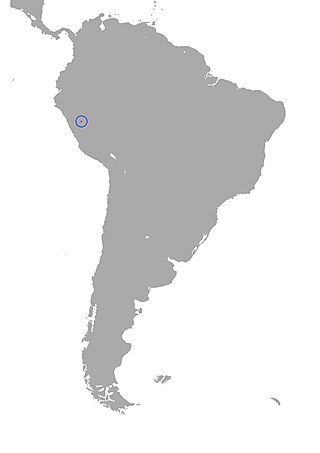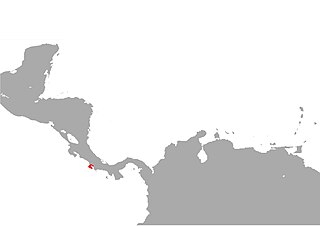Caecilia albiventris is a species of caecilian in the family Caeciliidae. It is endemic to Suriname. Its natural habitats are tropical moist lowland forests, plantations, rural gardens, and heavily degraded former forest.

Caecilia attenuata is a species of caecilian in the family Caeciliidae. It is found in Ecuador and Peru. Its natural habitats are subtropical or tropical moist lowland forests, plantations, rural gardens, and heavily degraded former forest.

Caecilia bokermanni is a species of caecilian in the family Caeciliidae. It is found in Colombia, Ecuador, and possibly Peru. Its natural habitat is subtropical or tropical moist lowland forests.
Caecilia caribea is a species of caecilian in the family Caeciliidae. It is endemic to Colombia. Its natural habitats are subtropical or tropical moist lowland forests, subtropical or tropical moist montane forests, plantations, rural gardens, and heavily degraded former forest.
Caecilia corpulenta is a species of caecilian in the family Caeciliidae. It is endemic to Colombia. Its natural habitats are subtropical or tropical moist montane forests, swamps, plantations, rural gardens, and heavily degraded former forest.
Caecilia crassisquama is a species of caecilian in the family Caeciliidae. It is endemic to Ecuador and only known from the holotype collected in "Normandia, Zuñía, Río Upana", now in the Sangay National Park. It is a subterranean species that was collected in montane forest.
Caecilia degenerata, the Garagoa caecilian, is a species of caecilian in the family Caeciliidae. It is endemic to Colombia and known from the Cordillera Oriental in Boyacá, Santander, and Cundinamarca Departments. Its natural habitats are montane forests. This subterranean species is apparently common in parts of its range. Deforestation might be a threat to it.
Caecilia dunni is a species of caecilian in the family Caeciliidae. It is endemic to Ecuador and known from the Amazon basin in Napo and Pastaza Provinces. The specific name dunni honors Emmett Reid Dunn, a prominent American herpetologist. Common name Dunn's caecilian has been coined for it.
Caecilia guntheri is a species of caecilian in the family Caeciliidae. It is found in Colombia and Ecuador. Its natural habitat is subtropical or tropical moist montane forests.

Caecilia inca is a species of caecilian in the family Caeciliidae. It is endemic to Peru and only known from the holotype collected in 1944 from "Fundo Sinchona" in the Loreto Region. There are doubts regarding taxonomic validity of this species. Common name Fundo Sinchona caecilian has been coined for it.
Caecilia leucocephala is a species of caecilian in the family Caeciliidae. It is found in Colombia, Ecuador, and Panama. Its natural habitats are subtropical or tropical moist lowland forests, plantations, rural gardens, and heavily degraded former forest.
Caecilia mertensi is a species of caecilian in the family Caeciliidae from South America. The type locality is imprecise: the holotype was purportedly collected in "Seychelle Isle", but most likely originates from South America. However, more recently, several specimens have been collected from Mato Grosso, Brazil. The specific name mertensi honors Robert Mertens, a German zoologist and herpetologist. Common name Mertens' caecilian has been coined for this species.

Caecilia nigricans, commonly known as the Rio Lita caecilian, is a species of amphibian in the family Caeciliidae. It is a subterranean species located in Colombia, Ecuador, and Panama and its natural habitats include moist, subtropical or tropical lowland forests, plantations, rural gardens, and foothill forests. The species is of least concern, as it can be found in several protected areas in Colombia like Darién National Park, however it is still threatened by human activities like deforestation.
Caecilia occidentalis is a species of caecilian in the family Caeciliidae. It is endemic to the Northwestern Andean montane forests within Colombia. Its habitat is subtropical or tropical moist montane forest, plantation, rural gardens, urban area, and degraded former forest.
Caecilia subdermalis is a species of caecilian in the family Caeciliidae. It is endemic to Colombia. Its natural habitats are subtropical or tropical moist montane forests, pastureland, plantations, rural gardens, and heavily degraded former forest.
Caecilia tenuissima is a species of caecilian in the family Caeciliidae. It is found in Colombia and Ecuador. Its natural habitats are subtropical or tropical moist lowland forests, plantations, rural gardens, and heavily degraded former forest.
Caecilia thompsoni, commonly called Thompson's caecilian, is a species of caecilian in the family Caeciliidae. It is endemic to Colombia. It is the largest of the worm-like caecilians and reaches a length of 1.5 m (5 ft) and can weigh up to about 1 kg (2.2 lb). Its natural habitats are subtropical or tropical moist lowland forest, subtropical or tropical moist montane forest, plantations, rural gardens, and heavily degraded former forest.

Oscaecilia osae is a species of caecilian in the family Caeciliidae. It is endemic to Costa Rica and is only known from the Golfo Dulce area, on the Pacific Ocean side of Costa Rica. The specific name osae refers to its type locality, the airstrip at La Sirena, being located on the Osa Peninsula. It is also known as the airstrip caecilia or airstrip caecilian.
Sylvacaecilia is a monotypic genus of caecilian in the family Grandisoniidae. The only species is Sylvacaecilia grandisonae, also known as the Aleku caecilian or Ethiopian caecilian. It is endemic to southwestern Ethiopia and known from the Gambela, Oromia, and Southern Nations, Nationalities, and Peoples' Regions.






